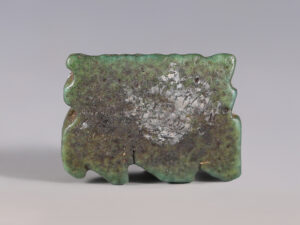For the Ancient Egyptians, amulets were not only decorative but also considered to bestow power and protection upon the wearer. Many amulets have been found inside the wrapping of mummies to ensure a safe journey into the afterlife, but amulets were also used by the living for protection or in order to have their wishes granted. Amulets, depending on their type or form, had different meanings, with small amulets depicting the gods, whether in a human or animal form, thought to have induced protective powers over the wearer.
The Uraeus, a highly stylised, upright, rearing form of the Egyptian cobra, was used as a symbol of royalty, deity, and divine authority in Ancient Egypt. It was also a symbol of the Lower Egyptian goddess Wadjet. When placed on the brow, the uraeus was thought to protect the wearer by spitting fire at their enemies. Worn as a head ornament as part of their crown by the pharaohs, adorning statues, used as a hieroglyphic, or as jewellery, the uraeus also appeared as amulets, such as this piece here. Cobras in general were associated with the Eye of Ra and the shedding of snake skin was also considered a symbol of regeneration. As such, the uraeus, though usually reserved for royalty, could be placed on the deceased as amulets on their forehead, torso, or at their feet, ensuring their protection and resurrection in the afterlife.
To find out more about Ancient Egyptian amulets please see our relevant blog post: Egyptian Amulets and their Meanings: Ancient Egyptian Gods.






















